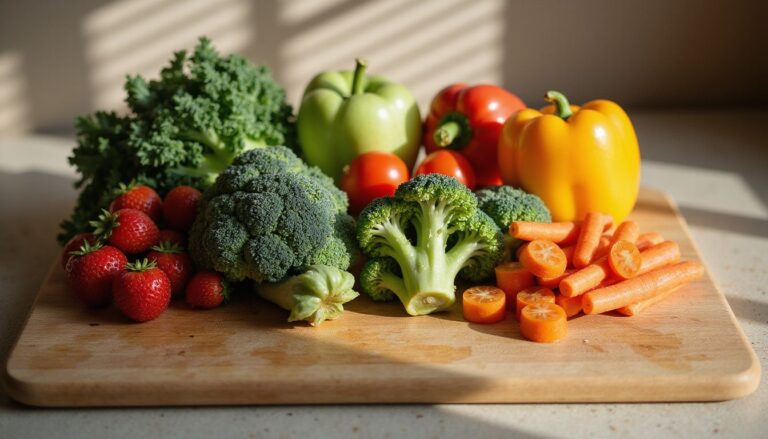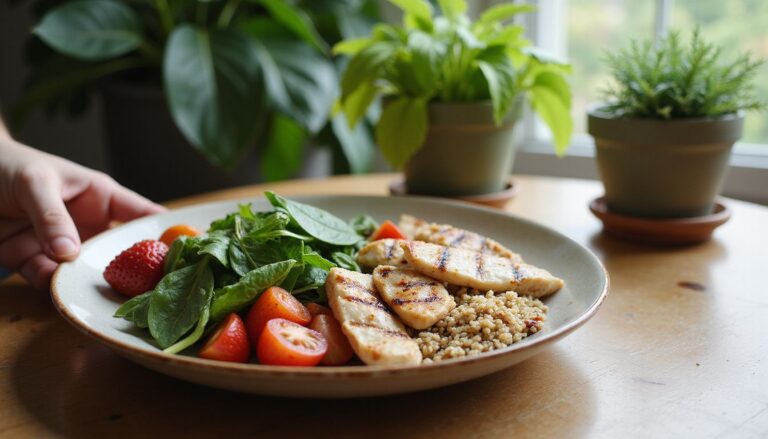The Quickest Way To Lose Weight: Top Tips For Fast And Healthy Weight Loss
Our Nutrition Assistant AI Suite will transform your body. You will lose fat, get toned, and build muscle. Gain confidence and optimal health.
You want to lose weight fast, yet safely, and you want steps that work. Most experts agree that steady progress, about 1 to 2 pounds per week, is the smartest target. This guide gives practical ways to start weight loss quickly without falling for fad diets or risky tricks.
Key Takeaways
- Aim for 1 to 2 pounds per week. Very rapid diets often backfire and raise health risks.
- Build plates with lean protein, healthy fats, whole grains, and at least four servings of vegetables daily.
- Pair regular aerobic exercise with strength training twice weekly. Resistance work helps protect muscle while cutting calories.
- Track food, water, activity, and progress with a journal or app. Eight cups of water a day is a common goal.
- Avoid very low-calorie plans without medical care. They can trigger nutrient gaps, gallstones, fatigue, and a slower metabolism.

Setting Realistic Weight Loss Goals

Clear, realistic goals keep you focused and motivated. Smaller action steps, stacked over time, make big goals feel possible.
Why is rapid weight loss often unsustainable?
Rapid weight loss usually means losing more than 2 pounds per week for several weeks. This often happens when calories drop too low. Severe cuts push early losses from water and muscle before much body fat changes.
Side effects can include fatigue, nausea, constipation, diarrhea, gout flares, and gallstones. These plans are unsafe for children, teens, pregnant people, and many older adults unless a clinician closely supervises them.
Fast-loss plans also increase the odds of regaining weight. This pattern, called yo-yo dieting, is linked with higher risks for heart disease and type 2 diabetes over time. Slow, steady changes allow your habits and metabolism to adjust, which improves long-term results.
How can I create a healthy and achievable weight loss plan?
Swap vague targets for action goals you can measure. Examples include walk 30 minutes daily, add one vegetable to each meal, or lift weights twice a week. Small, consistent changes reshape routines without shock.
Track what you eat and drink, including added sugar and convenience foods. Note how often you move, and when hunger or cravings hit. Identify habits that get in the way, like skipping breakfast or sipping soft drinks, and plan simple replacements.
Expect setbacks and keep going. Shift toward whole grains, healthy fats, lean protein, and more vegetables. These swaps lower calories, boost fullness, and still taste good.
What are the Best Nutrition Strategies for Fast and Healthy Weight Loss?
Healthy eating is your engine for safe, rapid progress. A balanced plate helps you feel full, protect muscle, and control calories.
Why should I focus on a balanced diet with protein, fat, and vegetables?
Protein supports muscle while dieting and helps control appetite. Choose lean meats, eggs, fish, beans, or low-fat dairy to meet needs with fewer calories. Healthy fats from olive oil, avocado, or nuts support vitamin absorption and hormones.
Fill half your plate with vegetables and add fruit daily. Fiber from produce and whole grains slows digestion and steadies blood sugar, which curbs hunger spikes. Whole grains like brown rice and whole-wheat bread offer longer energy and may help reduce belly fat.
Limit foods rich in added sugar. Favor natural sweetness from fruit. This pattern supports lasting weight management.
How can reducing sugar and refined carbs help me lose weight?
Cutting sugar and refined grains lowers calories fast and steadies appetite. Soft drinks, pastries, white bread, and white rice digest quickly, then hunger returns. Blood sugar and insulin rise sharply, which can spur more cravings.
Choose wholegrain cereal instead of sugary options. Drink water in place of sweet drinks. People who replace processed items with unprocessed foods often eat fewer calories and improve gut bacteria, which may support weight control.
What are the benefits of increasing dietary fiber intake?
Fiber helps you feel full on fewer calories. Fruits, vegetables, beans, and whole grains add volume to meals and slow digestion. That means fewer snacks and easier portion control.
Higher fiber intake is linked with a lower risk of long-term weight gain. It also supports better blood sugar and heart health.
How much water should I drink to stay hydrated during weight loss?
Water supports metabolism and can tame appetite. A common target is at least 8 cups, or 64 ounces, per day. You may need more if you exercise or sweat heavily.
Add lemon or lime for flavor without sugar. Drinking a glass before meals can reduce overeating and boost energy through the day.
Popular Diet Approaches for Quick Results
Some plans limit when you eat, others change what you eat. Choose the option you can follow consistently.
What is intermittent fasting and how does it work?
Intermittent fasting cycles between eating and fasting periods. The 16:8 method uses an eight-hour eating window and a sixteen-hour fast each day. The 5:2 approach includes two lower-calorie days, about 500 to 600 calories, and five regular days.
This style may lower insulin resistance, a condition where cells respond poorly to insulin, and encourage fat use. Early research suggests benefits for people with obesity or type 2 diabetes. Results vary, so pair fasting windows with balanced meals.
What are very low-calorie diets (VLCD) and are they safe?
A very low-calorie diet provides about 800 calories per day, often using meal replacements. Clinicians may suggest a VLCD for people with obesity who need rapid changes for medical reasons or before bariatric surgery.
Weight can drop 3 to 5 pounds per week. These plans should last no more than 12 weeks and only under medical supervision. Risks include muscle loss, gallstones, fatigue, digestive issues, and nutrient gaps. A registered dietitian can help ensure safety.
How does time-restricted eating support weight loss?
Time-restricted eating limits the hours you eat, such as 10 am to 6 pm. Fewer eating hours often means fewer calories and less night snacking. Some people find it simpler than counting every calorie.
Pair this approach with whole foods and protein. A short eating window does not replace food quality.
What should I know about low-carbohydrate diets?
Low-carb plans limit grains, sugar, and starchy vegetables. You may see fast water loss in the first week, then steady fat loss afterward. Focus on protein and non-starchy vegetables to protect muscle and manage hunger.
This plan is not for everyone. People with kidney disease or certain conditions should talk with a clinician first. Pay attention to side effects like fatigue or nutrient gaps, especially when cutting many foods at once.
How Does Exercise Help with Rapid Weight Loss?
Exercise burns calories and protects muscle while you diet. Think of it as your weight loss multiplier.
What aerobic exercises are best for weight loss?
Aerobic exercise raises heart rate and calorie burn. These options fit most fitness levels:
- Brisk walking for 30 minutes on most days.
- Running to increase calorie burn and heart strength.
- Cycling for joint-friendly cardio and leg power.
- Swimming for full-body, low-impact conditioning.
- Rowing to train upper and lower body together.
- Jump rope for fast calorie burn in short sessions.
- Dancing, like Zumba, to make cardio fun and social.
Pick activities you enjoy and can repeat. Consistency beats perfection.
How does strength training aid fat loss and muscle maintenance?
Strength training helps you keep muscle while eating fewer calories. Muscle burns more energy at rest than fat, which supports a healthy metabolism. Use dumbbells, resistance bands, kettlebells, or bodyweight moves like squats and push-ups.
Two sessions per week can make a clear difference. Research shows people who lift weights while dieting keep more lean mass than those who rely on cardio or diet alone.
Reference: A 2022 meta-analysis reported resistance training preserves lean mass during calorie restriction (PubMed).
What is high-intensity interval training (HIIT) and why is it effective?
HIIT alternates hard efforts with brief recovery. For example, sprint 30 seconds, then walk 60 seconds. Repeat for 20 to 30 minutes.
HIIT can burn more fat in less time than steady cardio. A 2019 review found greater body fat reductions with HIIT compared to moderate continuous training for many participants.
How can I make physical activity a daily habit?
Small moves throughout the day add up. Create cues and routines that make activity automatic.
- Take the stairs instead of the elevator.
- Park farther away and walk extra steps.
- Stand or walk during TV time.
- Split workouts into 10-minute bouts.
- Schedule exercise like an appointment.
- Choose activities you enjoy.
- Track workouts with an app or journal.
- Set clear goals, such as 8,000 steps.
- Join classes or friendly challenges.
- Work movement into chores and errands.
- Drink water before and after activity.
I set a daily alarm for a short walk after lunch. That one change made me more consistent and improved my energy.
Lifestyle Changes That Support Weight Loss
Simple daily habits can boost results without feeling extreme. Small choices compound over weeks and months.
How can mindful eating improve my weight loss results?
Mindful eating means paying close attention while you eat. Turn off screens and slow down. Notice taste, texture, and fullness cues.
This practice helps you stop before you feel stuffed. It reduces overeating and supports better long-term control around food.
Why is prioritizing sleep and managing stress important?
Adults need 7 to 9 hours of quality sleep each night. Too little sleep disrupts hormones that control hunger, including ghrelin, which increases appetite, and leptin, which signals fullness.
High stress raises cortisol, a hormone that can promote belly fat and cravings. Use simple tools like regular bedtimes, outdoor walks, and short breathing sessions. Talk with a healthcare professional if stress feels unmanageable.
How can reducing sedentary behavior help me lose weight?
Long sitting periods lower calorie burn and make it easier to gain weight. Stand up, stretch, or walk for a few minutes every hour. These breaks improve blood flow in muscles and support fat use.
Two extra hours of standing or light walking can add up to about 200 calories burned per day.
What are the best ways to track progress with apps or journals?
Tracking makes patterns visible. The more consistent your records, the more insight you gain.
- Log meals, snacks, and drinks to see where calories come from.
- Record steps, minutes of activity, and workout types.
- Weigh in at the same time of day each time.
- Track water intake to support energy and appetite control.
- Use app features to scan barcodes and view nutrition facts.
- Set reminders so tracking becomes routine.
- Note wins and setbacks to keep motivation strong.
- Briefly record stress or triggers that influence eating.
- List any supplements if you want to monitor effects.
Summary: Track what matters most to you, then use the data to fine-tune your plan.
What Common Mistakes Should I Avoid During Weight Loss?
A few common errors slow progress. Avoid these traps to protect results and health.
Why should I avoid skipping meals?
Skipping meals often leads to overeating later. Hunger builds and pushes you toward high-calorie choices at night. Studies from major medical centers report that breakfast skippers tend to eat more later in the day.
Regular meals stabilize energy and mood. Balanced plates make it easier to stick to your plan.
What are the dangers of over-restricting calories?
Cutting calories too far can drain energy and reduce muscle, water, and even bone mass. Risks include gallstones, gout, constipation, diarrhea, and nutrient deficiencies.
Very low intakes can cause hair thinning, joint aches, or dizziness. Protect your metabolism by keeping a moderate deficit and eating enough protein and produce.
Why is relying solely on fad diets problematic?
Fad diets often cut entire food groups or slash calories. Quick losses tend to return once the plan ends. Many lack key nutrients and create strong cravings.
A balanced, evidence-based approach is safer. It is also easier to maintain through busy seasons and social events.
How can I focus on long-term weight loss sustainability?
Build skills that last: meal planning, daily movement, and tracking. Expect lapses, then restart quickly. Progress, not perfection, keeps results stable.
People who keep simple logs, even once or twice a week, are more likely to maintain weight loss over time.
Health Benefits of Losing Weight Quickly and Safely
Safe, steady weight loss can pay off fast. Many people notice improvements in health and daily energy.
How does weight loss reduce the risk of type 2 diabetes?
Losing excess weight improves how your body uses insulin, the hormone that moves sugar from blood into cells. Even a 5 to 10 percent drop in body weight can lower diabetes risk. The Diabetes Prevention Program showed up to a 58 percent risk reduction with healthy changes.
Reducing belly fat is especially helpful. Better blood sugar control supports long-term health.
What improvements can I expect in cardiovascular health?
Losing 5 to 10 percent of body weight can reduce blood pressure and improve cholesterol patterns. HDL, the good cholesterol, may increase, while LDL, the bad cholesterol, often drops.
You may feel everyday tasks get easier as your heart and blood vessels work more efficiently.
How does losing weight affect energy levels and mental clarity?
Less excess weight means your body moves with less effort. Balanced meals support steady fuel for the brain, which can lift focus and mood.
Many people report fewer afternoon slumps and better productivity as weight and sugar intake drop.
What overall well-being benefits come from safe weight loss?
Safe weight loss can lower the risk of long-term disease, reduce joint pain, and improve sleep quality. Confidence often rises as habits take root.
Healthy eating patterns support a stronger immune system and better digestion, which adds to daily comfort and well-being.
What Are the Potential Risks of Rapid Weight Loss?
Very fast results can strain your metabolism and energy. Understanding these risks helps you choose a safer path.
How can rapid weight loss cause muscle loss and nutrient deficiencies?
Severe calorie cuts push the body to use muscle for fuel, especially if protein is too low. Losing muscle lowers daily calorie burn, which makes maintenance harder later.
Restricted diets can miss iron, calcium, B vitamins, and other key nutrients. Signs include fatigue, hair thinning, poor focus, or digestive problems. Many medical VLCDs add supplements to reduce these gaps.
Key Data:
- Muscle loss rises sharply when daily calories drop below about 1,200 for women or 1,500 for men.
- Clinician-guided VLCDs often include vitamins and minerals.
- Nutrient gaps can weaken immunity and reduce energy.
Short summary: Extreme restriction raises the risk of muscle loss and nutrient shortfalls.
What impact does rapid weight loss have on metabolism?
Over-restriction slows metabolism, so your body burns fewer calories at rest. Muscle loss makes this worse because muscle tissue is more active than fat tissue.
In one study from 2016, people who lost large amounts quickly saw their resting metabolism drop by about 500 calories per day after the diet. This reduction increases the chance of regaining weight unless healthy habits continue.
Why is there a risk of weight regain after losing weight quickly?
Rapid loss often triggers stronger hunger signals and a lower daily burn. When strict rules end, old habits return and weight climbs. Research shows many people regain a large share of fast losses within a few years.
Protect results with a stable routine. Keep protein high, keep portions steady, and keep moving.
Tips for Maintaining Weight Loss Long-Term
Maintenance is a skill you can practice. Keep the core habits that helped you lose weight in the first place.
How do I transition to a sustainable eating plan?
Replace meal replacements with real foods over a few weeks. Build meals around vegetables, fruit, whole grains, and lean protein. Drink water instead of sugary drinks.
Use a simple food journal or app to track your changes. Small adjustments compound into a stable routine.
Why should I continue regular physical activity?
Activity helps lock in your results. Aim for at least 150 minutes each week, including two strength sessions. People who stay active keep more weight off than those who slow down.
Short walks, home circuits, or resistance bands all count. Variety prevents boredom and supports consistency.
How can building a strong support network help maintain weight loss?
Share goals with friends, family, or a group. Social support raises accountability and motivation. One study in Obesity found people with support were 33 percent more likely to maintain losses at one year.
Ask your circle to join you for walks, healthy meals, or check-ins. Progress feels easier with a team.
Frequently Asked Questions
Quick answers can help you choose safe next steps. Use these to guide your plan and questions for your clinician.
Can I lose weight quickly without exercising?
You can reduce weight through diet alone, but results may fade. Severe restriction is hard to maintain and can lower metabolism. A healthcare professional should guide any strict plan to protect your health.
Adding even light activity helps protect muscle and mood. It also raises daily calorie burn, which supports better maintenance.
How much weight is safe to lose in one week?
Most experts recommend 1 to 2 pounds per week. This pace protects muscle, energy, and nutrition. Faster loss should be supervised by a healthcare professional.
Gradual changes make habits stick. They also reduce the risk of rebound weight gain.
What are the best foods for fast weight loss?
Build meals from vegetables, fruit, whole grains, beans, lentils, eggs, fish, and lean meats. Choose low-fat or fat-free dairy like Greek yogurt for protein without many calories. Drink water and limit added sugar.
Healthy fats such as olive oil, nuts, and avocado are helpful in small amounts. Fill half your plate with vegetables to improve fullness while controlling calories.
Conclusion
Fast, healthy progress comes from simple, repeatable steps. Set clear action goals, eat balanced meals, and keep protein and vegetables high. Cut added sugar and refined grains to reduce calories without losing satisfaction.
Move most days, lift weights twice a week, and track what you do. These habits help you lose weight and keep it off. If you have medical conditions, talk with a healthcare professional before major changes.
This article is for education, not medical advice. Start small, stay consistent, and celebrate steady weight loss as it adds up.
FAQs
1. What is the quickest way to lose weight while staying healthy?
Effective and safe weight loss combines a balanced diet, regular physical activity, and proper hydration. Research shows that including prebiotic-rich foods supports gut health, which can help with weight management. Studies suggest aiming for 1 to 2 pounds of weight loss per week is both fast and sustainable (CDC, 2022).
2. How do prebiotics support nutrition during weight loss?
Prebiotics are dietary fibers that feed beneficial gut bacteria. These nutrients improve digestion and may reduce cravings by helping you feel full longer. Clinical trials have found that people who eat more prebiotic foods often experience better appetite control and improved metabolic markers (Slavin, 2013).
3. Are there specific foods or habits linked to faster fat reduction?
Yes; eating whole grains, lean proteins, fruits, vegetables high in fiber such as those containing prebiotics like bananas or asparagus helps regulate hunger hormones. Limiting added sugars and processed snacks also leads to quicker results according to several nutritional studies.
4. Can personal experiences show how these tips work in real life?
After adding more prebiotic-rich vegetables into my meals along with daily walks, I noticed steady progress over four weeks without feeling deprived or tired. Tracking food intake helped me stay consistent with healthy choices.
Summary: Fast yet healthy weight loss relies on evidence-based strategies such as increasing physical activity levels and consuming nutrient-dense foods rich in prebiotics for optimal nutrition outcomes.
References:
– Centers for Disease Control and Prevention (CDC). Losing Weight.
– Slavin JL (2013). Fiber and Prebiotics: Mechanisms and Health Benefits







